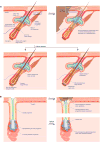Skin and Its Regenerative Powers: An Alliance between Stem Cells and Their Niche
- PMID: 29161590
- PMCID: PMC5797699
- DOI: 10.1016/j.devcel.2017.10.001
Skin and Its Regenerative Powers: An Alliance between Stem Cells and Their Niche
Abstract
Tissues have a natural capacity to replace dying cells and to heal wounds. This ability resides in resident stem cells, which self-renew, preserve, and repair their tissue during homeostasis and following injury. The skin epidermis and its appendages are subjected to daily assaults from the external environment. A high demand is placed on renewal and regeneration of the skin's barrier in order to protect the body from infection and dehydration and to heal wounds. This review focuses on the epithelial stem cells of skin, where they come from, where they reside, and how they function in normal homeostasis and wound repair.
Keywords: cellular plasticity; epidermis; hair follicle; homeostasis; regeneration; skin stem cells; stem cell niche; wound healing.
Copyright © 2017 Elsevier Inc. All rights reserved.
Figures







References
-
- Ahtiainen L, Lefebvre S, Lindfors PH, Renvoise E, Shirokova V, Vartiainen MK, Thesleff I, Mikkola ML. Directional cell migration, but not proliferation, drives hair placode morphogenesis. Dev. Cell. 2014;28:588–602. - PubMed
-
- Ansell DM, Kloepper JE, Thomason HA, Paus R, Hardman MJ. Exploring the “hair growth-wound healing connection”: anagen phase promotes wound re-epithelialization. J. Invest. Dermatol. 2011;131:518–528. - PubMed
Publication types
MeSH terms
Grants and funding
LinkOut - more resources
Full Text Sources
Other Literature Sources
Medical

